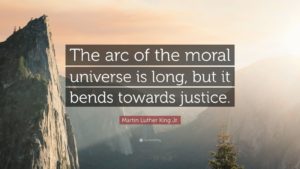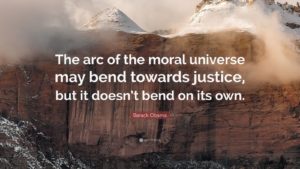Marty Levine
October 12, 2021
In 1968, shortly before he was murdered, Dr. Martin Luther King, Jr, was still giving us hope that we would overcome. Speaking at the National Cathedral, he said we needed to keep not become despondent when things seem to be stuck because “the arc of the moral universe is long, but it bends toward justice.”

I am now wondering if he was correct.
I’m reading “America on Fire”, a recently published book looking at police and community violence written by Elizabeth Hinton, a Yale Associate Professor of History & African American Studies and Law. Spurred to write by the series of police murders of Black men and women and the protests and violence that arose in response, Professor Hinton has found a history of a national failure to learn and unwillingness to confront reality. Time after time police violence was the match that set off violent uprisings in Black communities which had been marginalized and systematically kept in poverty and neglect. Time after time she found we said we knew that we needed to invest in people and communities. And time after time, she found, that we ignored these lessons and turned our resources to defending the built-in bias, expanding our police forces, and expanding our prison systems.
Hinton’s conclusion, formed after she analyzed more than 2,200 separate community outbreaks between 1964 (Harlem, New York) and 2001 (Cincinnati, Ohio) was that the conflict is more than just a symptom of racism and poverty. “They happened when police seemed to be there for no reason, or when the police intervened in matters that could be resolved internally (disputes among friends and family). Rebellions began when the police enforced laws that would almost never be applied in white neighborhoods (laws against gathering in groups of a certain size or acting like a “suspicious person”). Likewise, they erupted when police failed to extend to residents the common courtesies afforded to whites (allowing white teenagers to drink in a park but arresting Mexican American teens for the same behavior).”
Those in power were interested in protecting their power and the status quo rather than bringing the changes they promised. They listened to the voices of the hurting communities, said pious words about their now seeing the pain of those left out of the American Dream, vowed to take on the underlying and systemic problems that had been ignored, and then did little beyond strengthening the police.
Hinton described the formula: “A federal civil rights commission or a state or local-level human relations commission would be constituted to investigate, produce a report, and recommend a path forward. Yet even as these commissions succeeded in doing the very thing local officials refused to do—talk about root causes—they can by and large be judged failures…For its time, the Kerner Report was a mostly progressive document. Highlighting the role of white racism in perpetuating inequality and segregation, the commission called for the full integration of Black citizens into ‘the mainstream of American life.’ Although the report placed the onus on Black Americans themselves to conform to ‘mainstream’ (read, “white”) cultural values and practices, the Kerner Commission argued that this goal could only be achieved by directing massive federal investment into “disadvantaged” communities. That effort would need to go well beyond existing War on Poverty programs in order to provide greater access to employment, education, and housing…”
As much as we said we would take on the root causes, we were not ready to make the dislocations needed to rebalance our society. We were not prepared to tolerate the discomfort and the disorientation of change, change that would limit privilege and redistribute wealth.
What we were ready to do was double down on policing. We expanded our prisons so that we became the world leader in imprisoning our own people. We were prepared to spend huge sums of money to change “officer friendly” into GI JOE, the police car into an armored vehicle, and community policing into a militarized force.
That investment brought little. Lives and communities were not improved, and the next uprising was just around the corner. “From the Kerner Commission onward, task forces and commissions frequently identified the structural causes of collective political violence and highlighted the dangers of entrenched racism. Corporations are not new to social justice rhetoric; the Eurostar sneaker brand promised to turn former Crips and Bloods into entrepreneurs after the 1992 rebellion in Los Angeles, but when the news cycle moved on, the company lost interest. Acknowledging the reality of systemic racism, renaming a Robert E. Lee High School to a John Lewis High School (as happened in Fairfax County, Virginia), making donations to social justice and anti-poverty organizations, and using the #BlackLivesMatter hashtag on social media—these are insufficient substitutes for the structural transformation that Black Americans have long been calling for.”
In cities across the nation, in state capitals, and in Washington we are still in a debate over shifting the balance from policing to changing the rotten roots that force people to live in decaying communities, send their kids to moldering schools, and struggle to feed their families.
Even the benign world of philanthropy has been touched by this fetish with policing, Nonprofit Foundations have been created in over two hundred cities designed to augment the already large police budgets. According to a recent report by Color of Change and Little Sis: “As communities across the nation demand critical investments in what will actually keep us safe, healthy, and housed, police foundations…funnel private money to policing and…the militarization of large and small police departments across the country. As private entities, police foundations and their corporate sponsors protect corporate interests and increase huge police budgets outside of government oversight, with no accountability to the communities that police are sworn to serve. The identities of private donors whose money goes towards purchasing police equipment and funding police programs should be public information — especially if the donations are coming from powerful corporations….claiming to provide equipment and technology that massively-funded police departments “can’t afford,” police foundations pay for police violence, from SWAT equipment to lethal police dogs officers use to terrorize Black communities, repress protests and injure racial justice protesters. Corporations cannot claim to “stand with BLM protesters” on social media while funding violence against protesters and Black people behind closed doors.”
We seem trapped in an endless loop. We are more comfortable investing in another “new” approach to policing even after the last “new” approach got us the same bad results. We are unwilling to take a different path. That is how entrenched the America of institutionalized racism and privilege is.

The 2020 uprisings and the impact of COVID-19 have made this a conclusion so easy to reach. But I struggle to accept that we are doomed to this pernicious cycle that leaves so many stuck in their pain and suffering. With the vision of the diverse faces that were on the streets demanding rea, systemic change to grab onto we can see that if that coalition, if the coalition that defeated Donald Trump one year ago, and if all people who still resonate to DR. King’s words stay in the fight I remain hopeful that this will be the time that we break the pattern and make the changes we know must be made.
